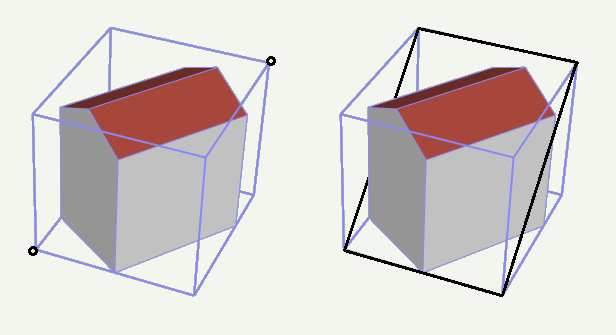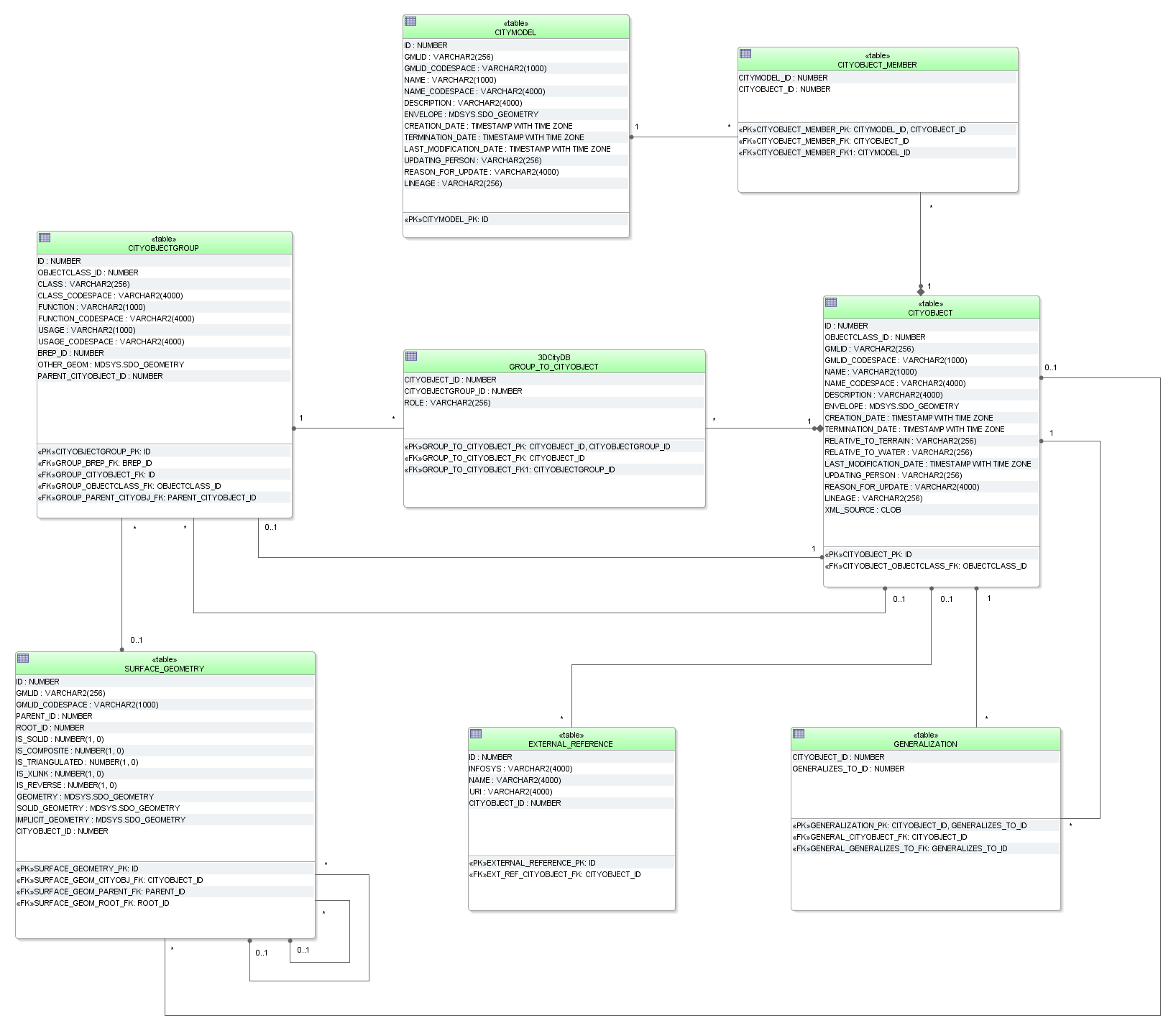3.2.2. Core schema¶
CITYOBJECT, CITYOBJECT_SEQ
All CityObjects (and instances of the subclasses like Buildings etc.) are represented by tuples in the root table CITYOBJECT. The fields are identical to the attributes of the corresponding UML class, plus additional columns for metadata like LAST_MODIFICATION_DATE, UPDATING_PERSON, REASON_FOR_UPDATE and LINEAGE.
The bounding box (gml:Envelope) is stored as rectangular geometry using five points, that join the minimum and maximum x, y and z coordinates of the bounding box and define it completely. For backwards compatibility reasons (to Oracle 10g), the envelope cannot be stored as a volume.

Fig. 3.27 The CityObject’s envelope specified by two points with minimum and maximum coordinate values (left: black points) is stored as a 3D rectangle (right: black polygon using five points)
In order to identify each object, a unique identifier is essential. Therefore, the column GMLID stores the gml:id value of every city object. But since gml:ids cannot be guaranteed to be unique over different CityGML files, the column GMLID_CODESPACE is provided in addition. It may contain, for instance, the full path to the imported CityGML file containing the object. The combination of GMLID and GMLID_CODESPACE should be ensured to be unique for each CityObject.
The attributes NAME or NAME_CODESPACE can contain more than one
gml:name property. In this case they have to be separated by the
string ‘–/--’ (without quotes). The CityGML
exporter will then create multiple occurrences of <gml:name> elements.
The attribute OBJECTCLASS_ID provides information on the class affiliation of the CityObject (see Section 3.2.1.2). This helps, for instance, to identify the proper subclass tables.
The next free ID value for the table CITYOBJECT is provided by the database sequence CITYOBJECT_SEQ. This ID is also reused as foreign key in the separate tables of the different thematic features.
CITYMODEL, CITYMODEL_SEQ
CityObject features may be aggregated to a single CityModel. A CityModel serves as root element of a CityGML feature collection. In order to provide a unique identifier in table CITYMODEL, the next available ID value is provided by the sequence CITYMODEL_SEQ.
EXTERNAL_REFERENCE, EXTERNAL_REF_SEQ
The table EXTERNAL_REFERENCE is used to store external references; the foreign key CITYOBJECT_ID refers to the associated CityObject. The sequence EXTERNAL_REF_SEQ provides the next available ID value for EXTERNAL_REFERENCE.
CITYOBJECTGROUP, GROUP_TO_CITYOBJECT
The n:m relationship between an object group (table CITYOBJECTGROUP) consisting of city objects contained in CITYOBJECT is realized by the table GROUP_TO_CITYOBJECT, which associates the IDs of both tables. The following tables shows an example, in which two buildings are grouped to a hotel complex.
ID
|
CLASS
|
CLASS_
CODESPACE
|
FUNCTION
|
FUNCTION_
CODESPACE
|
USAGE
|
USAGE_
CODESPACE
|
1
|
NULL
|
NULL
|
Building
group
|
NULL
|
Hotel
|
NULL
|
CITYOBJECT_ID
|
CITYOBJECTGROUP_ID
|
ROLE
|
2
|
1
|
Main building
|
4
|
1
|
Annex
|
ID
|
OBJECTCLASS
_ID
|
GML_ID
|
ENVELOPE
|
CREATION
_DATE
|
TERMINATION
_DATE
|
2
|
26
|
Build1632
|
GEOMETRY
|
2015-02-02
09:26:07.441+01
|
NULL
|
4
|
26
|
Build1633
|
GEOMETRY
|
2015-02-02
09:26:07.441+01
|
NULL
|
1
|
23
|
Group1700
|
NULL
|
2015-02-02
09:26:07.441+01
|
NULL
|
For attributes CLASS, FUNCTION and USAGE there is an additional _CODESPACE column in order to specify the source of code lists used for values (e.g. by a globally unique URL). As a CityGML feature like CityObjectGroup can have multiple instances of attributes class, function and usage but only one target column exist in the table, values are separated by the string sequence ‘–/--’ (without quotes). The CityGML exporter will then create multiple occurrences of corresponding elements. Normalization rules were not applied in this case in order to avoid many joins when querying all information of building objects. Array types weren’t used either as their implementation varies between different database systems.
This concept applies to all CityGML features and can therefore be found in every object table (except for boundary surfaces of buildings, bridges and tunnels). They do not appear once in the CITYOBJECT table, because they are belonging to the namespace of a certain thematic module and should be stored along with other attributes of that feature.

Fig. 3.28 Database schema of the CityGML core elements